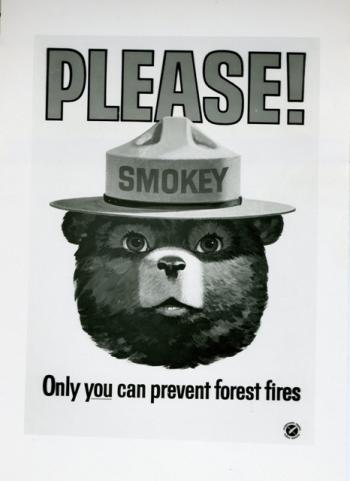 Some of you may recall the symbol of the United States Forest Service fire prevention program, Smokey Bear. Perhaps I am dating myself, however I distinctly recall posters and television commercials between Saturday morning cartoons depicting the almost human looking bear wearing his park ranger hat and blue jeans, with shovel in one hand and stern finger pointed with the other, convincingly proclaiming, “Only you can prevent forest fires . . . only you!” Using a bear to warn against the danger and destruction of forest fires makes perfect sense—bears live in the forest, and are pretty intimidating and powerful in appearance; only a fool would challenge a bear, especially if the bear has the ability to speak! Herein is the story of a living, breathing bear who became known as Smokey, and lived at the Smithsonian National Zoological Park in Washington, DC from 1950–1976.
Some of you may recall the symbol of the United States Forest Service fire prevention program, Smokey Bear. Perhaps I am dating myself, however I distinctly recall posters and television commercials between Saturday morning cartoons depicting the almost human looking bear wearing his park ranger hat and blue jeans, with shovel in one hand and stern finger pointed with the other, convincingly proclaiming, “Only you can prevent forest fires . . . only you!” Using a bear to warn against the danger and destruction of forest fires makes perfect sense—bears live in the forest, and are pretty intimidating and powerful in appearance; only a fool would challenge a bear, especially if the bear has the ability to speak! Herein is the story of a living, breathing bear who became known as Smokey, and lived at the Smithsonian National Zoological Park in Washington, DC from 1950–1976.
Smokey was born in 1950 in the Lincoln National Forest in New Mexico. He was found by members of the New Mexico Game and Fish Department during the aftermath of a fire that raged through forest, clinging to a charred pine tree, the soles of his feet badly burned, and his hair singed. He weighed all of five pounds, and his future appeared dim. Despite the poor odds for survival, he was nursed back to health by veterinarians in Santa Fe, NM and in June of 1950 was given to the federal government with the stipulation that his life be devoted to forest fire prevention and wildlife conservation.

Transporting Smokey to the National Zoological Park proved to be a challenge. Commercial airlines would not allow Smokey in the passenger cabin, and would not permit a person to accompany him in the baggage compartment. Fortunately, the Piper Aircraft Company became aware of this dilemma, and offered a Piper Pacer to serve as Smokey’s private airplane. Traveling in personalized style, the plane was adorned with a mural of Smokey with his paw in a sling and ranger hat on his head. The St. Louis Zoo reserved a special room for Smokey during an overnight fuel stop, and several hundred spectators, including members of the Boy Scouts, Girl Scouts, photographers, and media were awaiting his arrival in Washington, DC on June 27, 1950.
Smokey was a popular attraction at the National Zoo, and received millions of visitors during his twenty-six year residency. He became so popular in fact that he received more than 13,000 letters a week and was granted his own zip code.

Smokey officially retired on May 2, 1975 in a ceremony which anointed Little Smokey as Smokey Bear II. Smokey remained at the National Zoological Park until his passing on November 9, 1976. A Congressional resolution of 1974 stipulated that Smokey’s remains would be returned to New Mexico, where he would be buried at the Smokey Bear Historical Park in Capitan, NM, not far from where he was found twenty-six years prior. More than 250 people were on hand for his memorial service, and he received an official obituary on the front page of the November 11, 1976 edition of the Wall Street Journal. During his lifetime, his likeness appeared on millions of pieces of fire prevention literature and products, and countless hours of broadcast advertisements.
Produced by the Smithsonian Institution Archives. For copyright questions, please see the Terms of Use.

Leave a Comment